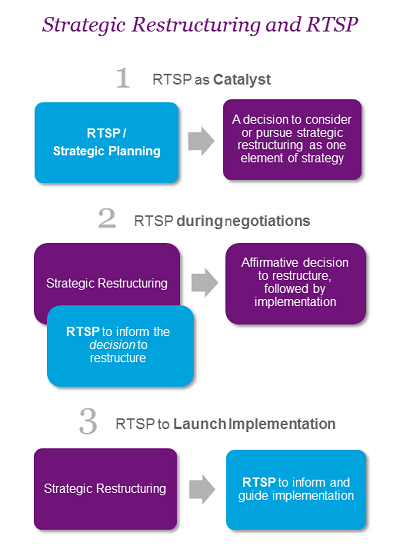Three Ways Real-Time Strategic Planning Advances Nonprofit Collaboration
With more than a decade of experience in helping nonprofits explore a whole spectrum of collaborative options, I have learned one crucial lesson for those seeking a successful partnership: It must be considered within the context of a broader organizational strategy.
After All…Collaboration is a Strategy
Partnership development needs to be approached thoughtfully. Wherever you are in the process — assessment, negotiation, or even integration — incorporating strategic thinking and conversations can can help you determine if (and how) the partnership supports your nonprofit’s organizational strategy and advances the mission.
Granted, many nonprofits lack the time, resources, and data to undertake strategic planning by itself, let alone while simultaneously pursuing a new partnership. But it is just these challenges we had in mind when we developed Real-Time Strategic Planning (RTSP). One aim was to help organizations consider their strategic focus in a fraction of the time (and expense) required of traditional strategic planning. We designed it to be quick and efficient, usually taking one or two days of facilitated discussion, with basic information gathering prior to the session. This makes it ideal to use in conjunction with a partnership development process.
RTSP 1-2-3
RTSP can precede a strategic restructuring process, can be done during the negotiations phase, or can immediately follow a decision to restructure, as a way to plan for implementation.

1. RTSP as Catalyst – Using RTSP can help an organization come to a decision to pursue strategic restructuring as one element of its overall strategy. RTSP asks organizations to consider their business model, the market in which they work, their competition, key trends, and their competitive advantage. Answering these questions can help nonprofit leaders better understand how a partnership can strengthen their organization and better fulfill its mission.
2. RTSP During Negotiations – Using the RTSP approach in conjunction with partnership negotiations can help identify alignment in potential partners’ primary strategies and lead to a more fully-informed decision to restructure (or not to do so). RTSP can be used to develop a desired business model for a merged organization, or even just to explore how one or more partners can complement and strengthen one another’s work. This kind of modeling is often helpful in addressing concerns, answering lingering questions, and leading to a decision on whether to partner.
3. RTSP to Launch Implementation – RTSP can also be used at the outset of a new partnership to inform and guide implementation. Organizations entering the implementation phase have a lot to do and little appetite for a daunting strategic planning process. But RTSP is an ideal way to help partners make the most of their combined strengths and set shared strategic priorities moving forward.
Making Strategic Restructuring Strategic
Nonprofits face many pressures and opportunities that may lead them to seek a partnership in some haste, without fully considering how it may advance or derail their organizational strategy. Making RTSP part of the partnership development process gives organizations a practical way of ensuring that their strategic restructuring is, in fact, strategic.
(Visit our website for more information about nonprofit strategy development and strategic partnerships.)


Comment section
1 thought on “Three Ways Real-Time Strategic Planning Advances Nonprofit Collaboration”